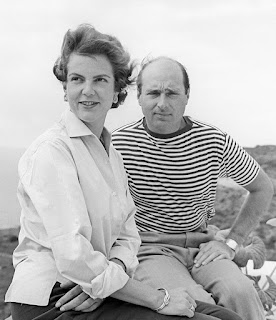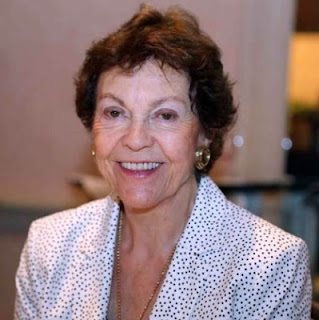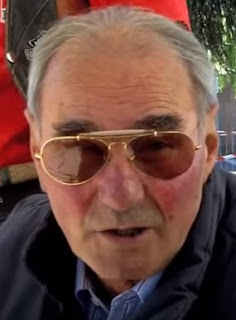Goalscorer who bounced back from two-year ban
(This article was written in 2017; sadly, Paolo Rossi passed away in 2020 at the age of 64)
 |
Paolo Rossi celebrates his goal in the 1982
World Cup final in Spain |
The footballer Paolo Rossi, whose goals steered Italy to
World Cup glory in 1982, was born on this day in 1956 in Prato in Tuscany.
At the peak of his career in club football, in which his
best years were with Juventus and Vicenza, Rossi scored almost 100 Serie A and
Serie B goals in seven seasons.
Yet for many his exploits with the Italian national team define
his career. In 48 appearances he scored 20 goals, including six in the 1982
finals in Spain, when he won the Golden Boot as the tournament’s top scorer and
the Golden Ball as the best player.
In 1982 he also won the Ballon D’Or, the prestigious award
given to the player of the season across all the European leagues, following in
the footsteps of Omar Sivori and Gianni Rivera to become the third Italian
player to win the vote, in which company he has since been joined by Roberto Baggio and Fabio Cannavaro.
His success story is all the more remarkable for the fact
that he scaled so many personal peaks after being banned from football for two
years in a match-fixing scandal, although he denied the accusations levelled at
him.
The 1982 World Cup saved his career and his reputation,
although the fairytale would never have happened but for the faith shown in him
by the national coach, Enzo Bearzot.
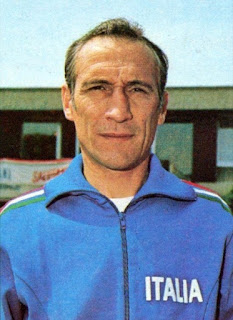 |
| Italy's coach, Enzo Bearzot, stood by Rossi |
Bearzot’s selection of Rossi for the squad he took to Spain
came barely a month after his suspension was lifted and sparked an outcry in
Italy. Apart from those who thought he was unworthy of wearing the Azzurri
shirt, others argued he would be too lacking in fitness to make an effective
contribution.
Yet Bearzot not only believed in Rossi’s innocence, he also
recalled the three goals the striker had scored in the 1978 World Cup finals in
Argentina and was convinced he could make an impact again.
His faith was borne out totally. Rossi looked off the pace at the start of the
tournament but found his feet memorably in the second phase, scoring all three
of Italy’s goals in a 3-2 win against a superior Brazil team that still ranks
as one of the greatest matches in World Cup history.
He went on to score both Italy’s goals as they defeated
Poland in the semi-finals and opened the scoring in Italy’s 3-1 victory over
West Germany in the final.
As a boy, Rossi played his first football with an amateur
team in the Santa Lucia area of Prato. At the age of 12, he was spotted by a
scout from Juventus, who had also been interested in his brother, Rossano, but
had sent him home after a year.
His mother, who had always been worried about Rossano having
to fend for himself in Turin, was reluctant to suffer a similarly anxious time
with Paolo, especially since Rossano’s dreams ultimately came to nothing.
 |
| Paolo Rossi in action for Juventus |
But Juventus were persuasive, offering substantial
inducements for him to sign, and ultimately in 1972 a deal was agreed.
It took a long time for his career to take off, however. He suffered
a series of serious knee injuries and apart from a handful of Coppa Italia
games he did not make any real progress towards a regular place in the first
team at Juventus.
A spell on loan with Como did not change his fortunes and he
might have been told to seek an alternative career had Lanerossi Vicenza, the
Serie B club, not stepped in with another loan deal.
Rossi had, until then, been seen as a winger, slight in
build but with the speed to beat defenders. Vicenza’s coach, Giovan Battista
Fabbri, had other ideas, reckoning that Rossi’s pace could be deployed in the
middle, despite his lack of physical stature.
It proved a masterstroke.
Rossi scored 21 goals to help Vicenza win promotion to Serie A and
followed it with 24 in the top flight as Vicenza finished second, a remarkable
performance. Rossi became the first
player to be top scorer in Serie B and Serie A in consecutive seasons.
In the event, Vicenza’s flame went out as quickly as it had
ignited. They paid 2.612 million lire to make Rossi their own player, making
him the world’s most expensive footballer, which he rewarded with another 15
goals, despite missing many games through injury. Yet Vicenza were relegated.
 |
Rossi (right) with Giovan Battista Fabbri, the
coach of Vicenza, who turned him into a striker |
Had they stayed up, Rossi might never have been embroiled in
the match-fixing allegations. Instead, in
order to continue playing in Serie A and continue his international career, he
went on loan to Perugia, who were heavily implicated in what became known as
the Totonero scandal after a match against Avellino, in which Rossi scored
twice, was found to have been rigged to end in a draw.
Rossi admitted he had been approached by a third party
interested in fixing the result but said he had agreed to nothing. Nonetheless, he was found guilty and banned
for three years, reduced on appeal to two.
Disillusioned, he threatened to leave Italy for a new life
elsewhere but Juventus bought him back from Vicenza and the bianconeri finally
saw the real Rossi. He helped them win the
Serie A title – the ‘Scudetto’ - the UEFA Cup and the European Cup during a
period when his very presence in a team seemed to guarantee their winning a
trophy.
Since retiring, Rossi has run a real estate company, opened
an agritourism complex in Bucine, near Arezzo, taken part in Ballando con le
Stelle – the Italian version of Strictly Come Dancing – and worked for several
newspapers and television stations as a columnist and pundit.
He has also run for election to the European Parliament and
worked on behalf of a number of charities.
Married to journalist Federica Cappelletti, he has three children.
 |
| The Castello dell'Imperatore in Prato |
Travel tip:
Paolo Rossi’s home city of Prato is the second largest in
Tuscany after Florence and has a considerable number of historic churches and
palaces and two castles, yet is rarely part of anyone’s tourist itinerary. Attractions include beautiful frescoes by
Filippo Lippi inside the Duomo and the external pulpit by Michelozzo and
Donatello, the beautiful Palazzo Pretorio and Piazza del Comune where it sits. The remains of Castello dell’Imperatore are also
worth exploring. Prato’s traditional
textile industry, which today employs many of the city’s large Chinese population,
once saw it described as ‘the Manchester of Italy.’
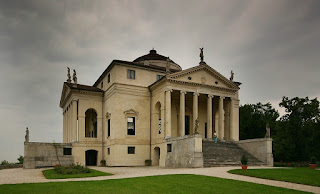 |
| Palladio's Villa Capra, known as La Rotonda |
Travel tip:
Known as both the city of Palladio and, on account of its
historical trade in precious metals, the ‘city of gold’, Vicenza is one of the
gems of the Veneto, with a centre rich in beautiful architecture, much of which
has been built or influenced by the 16th century architect Andrea
Palladio, who also left his mark on the area by building many impressive villas
in the countryside around Vicenza, the most famous of which, the symmetrically
four-sided Villa Almerico Capra, commonly known as La Rotonda. There are some
23 buildings in the city itself that were designed by Palladio, including
perhaps the city’s most popular attraction, the Teatro Olimpico, which was his
last work.
Home





